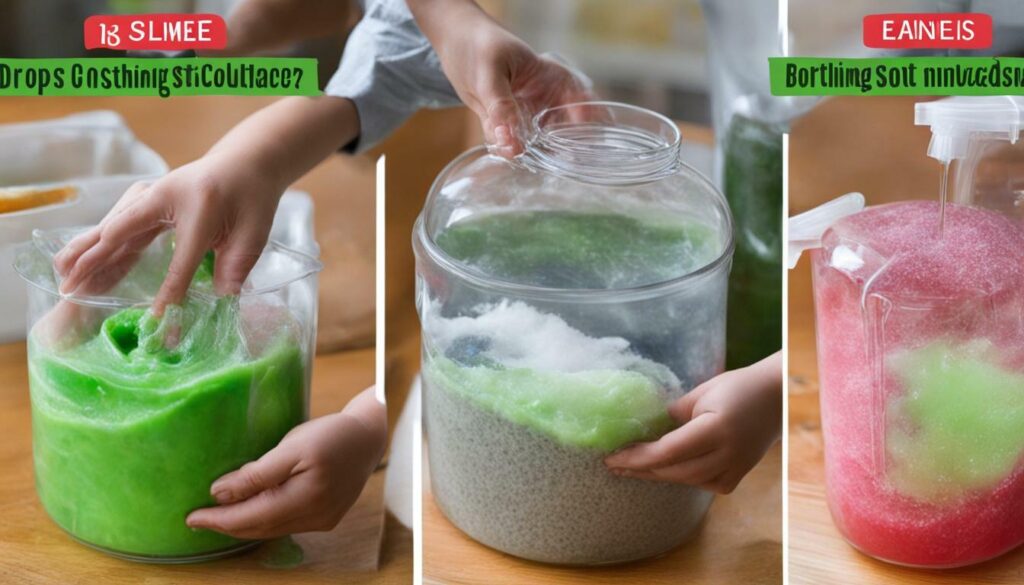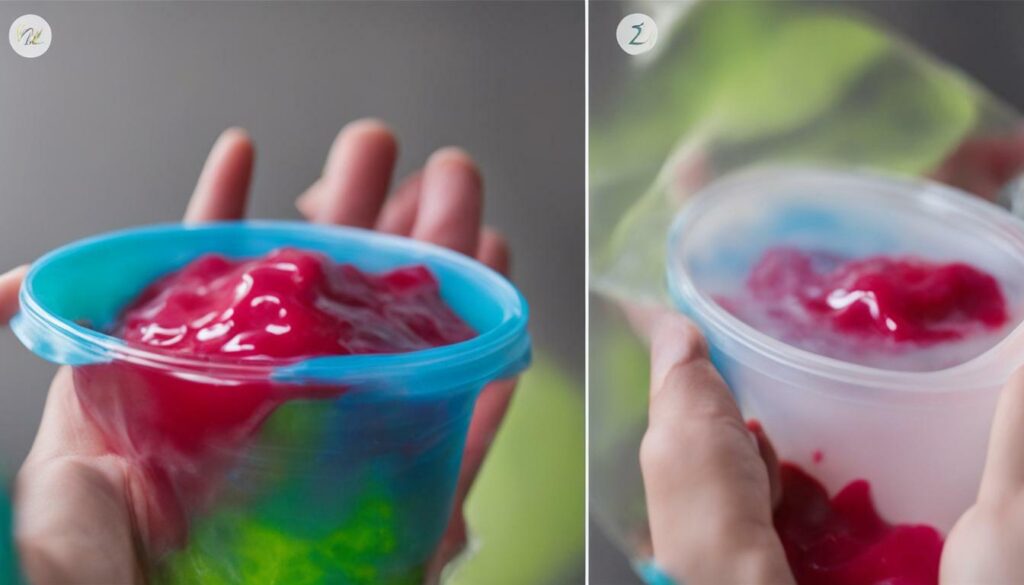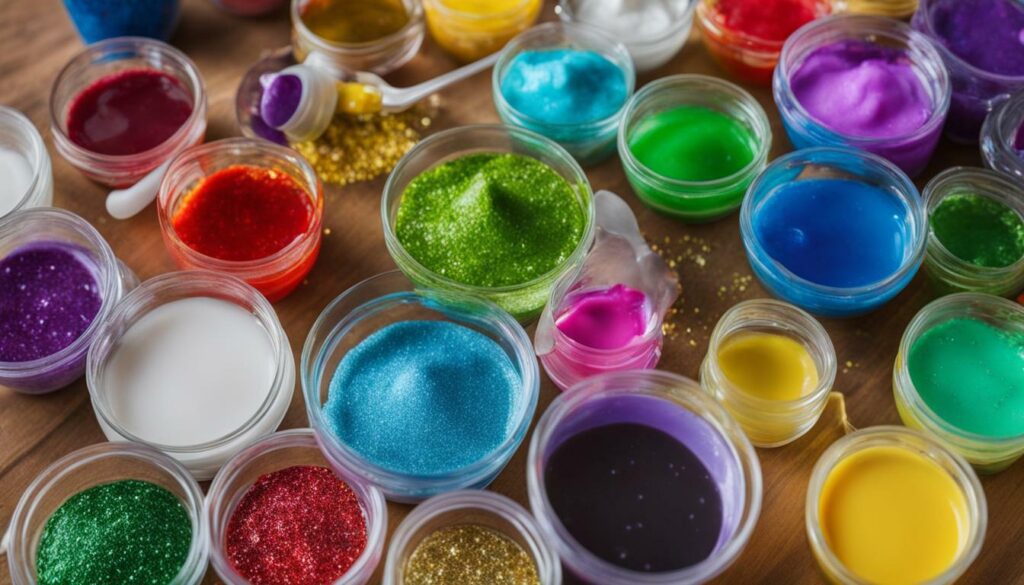Are you tired of dealing with sticky slime that gets everywhere? Learn how to make slime less sticky by using the right ingredients. By following these tips and tricks, you can create homemade slime that is stretchy and fun without the mess.
In order to make slime less sticky, it’s essential to understand the key ingredients that contribute to its texture. By using the right combination of ingredients, you can achieve a non-sticky and stretchy slime that provides hours of playtime fun. Let’s explore these ingredients in more detail.
Key Takeaways
- Knead slime to help it stick to itself and reduce stickiness.
- Adding contact solution or baby oil can also help reduce the stickiness of slime.
- Allowing slime to sit out and get some air can make it less sticky.
- Using the right ingredients and accurate measurements are crucial for successful slime-making.
- Clear glue is preferable for less sticky slime, but white glue can also work with slightly more activator.
Tips for Kneading and Adding Solutions to Reduce Stickiness
Master the art of kneading and find out how contact solution and baby oil can transform your sticky slime into a delightfully smooth and stretchy creation. When making slime, it’s important to knead it thoroughly to help the ingredients bind together and reduce stickiness. Kneading also helps the slime stick to itself rather than to your fingers, making it easier to play with and less messy.
If your slime is still sticky even after kneading, don’t worry! Adding a little more contact solution or baby oil can do wonders. Contact solution contains ingredients that help activate the slime and reduce stickiness. Simply add a few drops at a time and knead the slime until you achieve the desired consistency. Similarly, adding a small amount of baby oil can make the slime less sticky and more stretchy.
It’s important to note that some slime recipes may require different amounts of contact solution or baby oil, so it’s always a good idea to read the recipe thoroughly before starting. Experiment with small increments to avoid making the slime too runny or stiff. Remember, the goal is to achieve a non-sticky, stretchy texture that provides hours of fun and sensory play.
Expert Tip: Letting the Slime Sit Out
Another trick to reduce stickiness is letting the slime sit out for a while. Allowing it to get some air helps the excess moisture evaporate, making the slime less sticky. Simply place the slime in a container with a lid or cover it with a cloth and let it sit for about 24 hours. Check the slime periodically to see if it has reached the desired consistency. This method can be especially helpful if your slime is very sticky and needs some extra time to dry out.


By following these tips and tricks, you can create a slime that is less sticky and more enjoyable to play with. Remember, kneading the slime, adding contact solution or baby oil, and letting it sit out are all effective ways to achieve a smoother, stretchier texture. Have fun experimenting with different ingredients and measurements to find the perfect recipe for your non-sticky slime!
Allowing Slime to Air Out and Proper Ingredient Measurement
Learn why giving your slime some “me time” and ensuring precise ingredient measurement can make all the difference in achieving the perfect non-sticky consistency. When making slime, it’s important to let it sit out and air for a while before playing with it. This allows the slime to settle and lose some of its stickiness. By giving your slime this “me time,” you’ll find that it becomes less sticky and easier to handle.
Another crucial factor in creating less sticky slime is precise ingredient measurement. Accurately measuring each ingredient ensures the right balance and texture of your slime. Too much or too little of a certain ingredient can throw off the entire recipe and make the slime stickier than desired. To achieve optimal results, carefully follow the instructions and measure each ingredient precisely.
| Ingredient | Measurement |
|---|---|
| Glue | 1 cup |
| Slime Activator | 1 tablespoon |
| Food Coloring | A few drops |
By using the suggested measurements and taking your time to allow the slime to sit out, you’ll have a better chance of achieving a less sticky consistency. Remember, patience is key when it comes to making slime. Rushing the process or neglecting to let the slime air out can result in a stickier texture. So take your time, follow the instructions, and enjoy the process of creating your perfect non-sticky slime!


Choosing the Right Glue and Slime Activator
Discover the secret to less sticky slime by selecting the perfect glue and slime activator combination for your slime-making adventures. The right ingredients can make all the difference in achieving a non-sticky, stretchy slime that will provide hours of fun.
When it comes to glue, clear glue is the preferred choice for less sticky slime. Clear glue has a smoother texture and helps create a more transparent slime. However, if you don’t have clear glue on hand, white glue can still work. Just keep in mind that you may need to add slightly more activator to achieve the desired consistency.
Now let’s talk about slime activators. The right slime activator is crucial in achieving the perfect slime texture. Saline solution and borax powder are two popular choices. Saline solution, which is typically used for contact lenses, can be added in small amounts until the slime reaches the desired consistency. Borax powder, when mixed with water, also acts as an effective slime activator. It’s important to measure the activator accurately to avoid ending up with a sticky slime.
Tips for Choosing the Right Glue and Slime Activator
- Clear glue is preferable for less sticky slime, but white glue can work too with slightly more activator.
- Measure the glue and activator accurately to ensure the right consistency.
- If using saline solution as a slime activator, add it in small amounts until the desired texture is achieved.
- If using borax powder as a slime activator, mix it with water before adding it to the slime mixture.
By carefully selecting the right glue and slime activator combination and following these tips, you can create slime that is less sticky and more enjoyable to play with. So gather your ingredients, get creative, and have fun making slime!
| Glue Type | Advantages | Disadvantages |
|---|---|---|
| Clear Glue | Smooth texture, creates transparent slime | May be more expensive |
| White Glue | Readily available, more affordable | May require more activator |
Remember, the key to less sticky slime lies in choosing the right glue and slime activator, and following the recipe instructions carefully. With the right combination and a little experimentation, you can create slime that is stretchy, fun, and less likely to stick to your hands.


Achieving the Right Consistency with the Ideal Slime Activator
Find out how to achieve the perfect slime consistency by using the ideal slime activator – saline solution or borax powder – and bid farewell to sticky mishaps during playtime.
If you want to make slime less sticky, there are a few tips and tricks you can try. First, kneading the slime helps it stick to itself rather than to your fingers. Adding a little more contact solution or baby oil can also help reduce stickiness. Letting the slime sit out to get some air can also make it less sticky.
Additionally, using the right ingredients and measuring them accurately is important for a successful slime recipe. It’s also helpful to read the recipe thoroughly before starting. Clear glue is preferable for less sticky slime, but white glue can work too with slightly more activator.
Finally, using the right slime activator, such as saline solution or borax powder, is key to achieving the right consistency. These activators help bind the ingredients together and create a stretchy, non-sticky slime that is perfect for playtime fun. Just remember to use them in the right proportion, following the recipe instructions.
